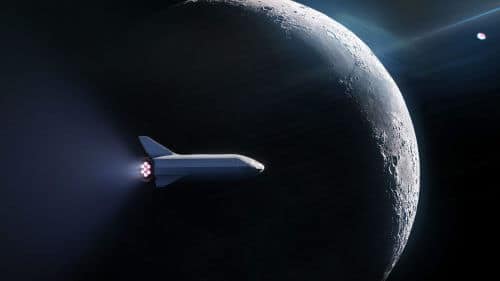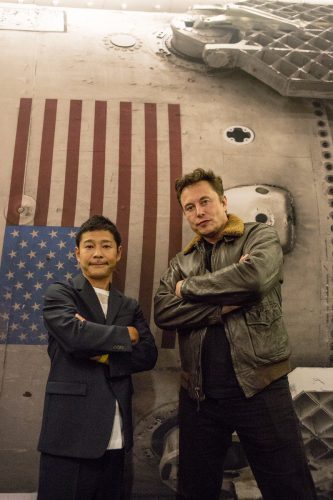This was announced by SpaceX President Elon Musk at an event held at the company's offices in California a few days ago. According to him, the amount that will be paid by Mazawa (which he did not specify) will help in the development of the new BFR Big Falcon Rocket spacecraft that one day may transport astronauts to Mars and beyond with the help of supply facilities along the way

Since Elon Musk's announcement of the latest addition to the SpaceX rocket family in September 2016, the general public and the space community have been waiting for updates on its progress. "Big Falcon Rocket" (PFR), the massive launch vehicle is a central component of Musk's plan to develop space tourism services for orbit around the Earth and the Moon. It will also be the tool that will allow Musk to realize his vision of sending astronauts and colonists to Mars.
A few months ago, Musk announced that the BFR would be ready to launch into orbit around the Earth in 2020. At a press conference held on Monday, September 17 at the SpaceX offices in California, Musk announced that a Japanese billionaire named Yusaku Mazawa, who is also a well-known art curator, would be the first tourist to fly into orbit around the moon
In fact, the amount that will be paid by Mazawa will make it possible to finance the development of the spacecraft and its launch in 2023. The mission will last about a week and will include a launch on the BFR launcher, circling the moon at a distance of about 200 km from its surface and returning to Earth.

This is the second time Musk has proposed a plan to send people to the moon. On February 27, 2017, Musk announced at a press conference in Cape Canaveral that SpaceX will launch two private astronauts to orbit the moon aboard the manned Dragon spacecraft - which is being developed for the purpose of carrying passengers for NASA to the International Space Station. This mission was supposed to use the Falcon Heavy launcher that had been successfully launched a few weeks earlier.
Musk has since canceled this mission in favor of developing BFR and launching it for a mission to the moon. According to Mazawa, Musk suggested that he take artists with him on the lunar journey and turn the entire flight into an art project under the hashtag #dearMoon. Among the passengers will be a film director, a painter, a dancer, a writer, a musician, a fashion designer, a sculptor, a photographer and a musician.
The #dearMoon website, which opened following the announcement, features a video that addresses the future of commercial space exploration and offers insights into Mazawa's hopes for the upcoming mission.
"Mazawa will invite artists to represent the Earth in its journey to the moon. They will describe how they feel when they see the moon, when they see the earth in its entirety. Their works will definitely become the heritage of mankind. An inspired, global and universal art project is about to begin." Musk said.
During the event, Musk presented updated details about the BFR rocket, which will one day replace Falcon 9 and Falcon Heavy. As the name clearly suggests, the BFR will be the most powerful launcher ever created. Similar to the Falcon 9, Falcon Heavy and the Dragon capsule, the BFR is intended for multiple use.
But unlike the Falcon 9 or Falcon Heavy, the BFR is a single system, consisting of a launcher and a large space unit (BFS). The accelerator and the space unit will reach a height of 118 meters and will be able to carry 100 tons of cargo into orbit around the Earth. However, Musk emphasizes that if the spacecraft is refueled in orbit around the Earth, it will also be able to reach Mars and beyond.
"Technically, we could take 100 tons all the way to Mars and build a supply base in orbit around it that would make it easier for us to reach the asteroid belt and Jupiter's moons afterwards. Therefore, BFR is designed to serve as an interplanetary transportation system, and to reach from Earth to anywhere in the solar system using the supply depots and refueling along the way."
The height of the spaceship itself will be 55 meters, and its volume will be about a thousand cubic meters under compressed air conditions. The spacecraft will also have fins that will help it control the Raptor engines in a wide range of atmospheric densities and speeds.
The BFR will have landing pads with seven Raptor engines that will ensure it can be reused and make multiple trips between Earth and other bodies in the solar system.
But perhaps the most important part of the conference was Musk's reference to the purpose of the BFR. According to him, "the BFR is essential to SpaceX's vision that humanity will become a multi-planetary species - not only for survival, but also to ensure a better future."
Astronaut Scott Kelly, who spent a year on the space station at the same time as his twin brother Mark, who remained on Earth, congratulated Mazawa, offered to join him on the flight and wrote: "Of course there are always those who expressed doubt about his ambitious plans and in particular his schedule. Musk has proven time and time again that he is able to make things happen (even if sometimes the timelines have to be changed). I'm sure I'm not alone when I say that I hope that Musk and the company he founded will advance rocket technology and the transformation of humanity into a space species and not just a terrestrial one."
For news on the subject at UNIVERSE TODAY
More of the topic in Hayadan:
